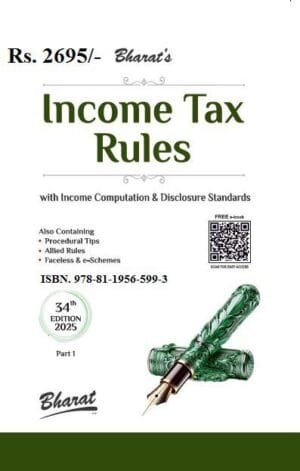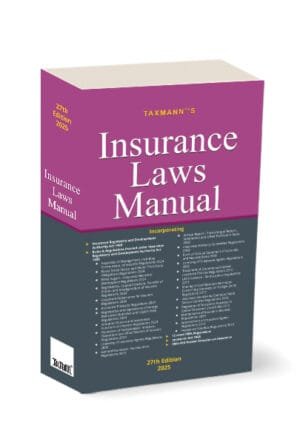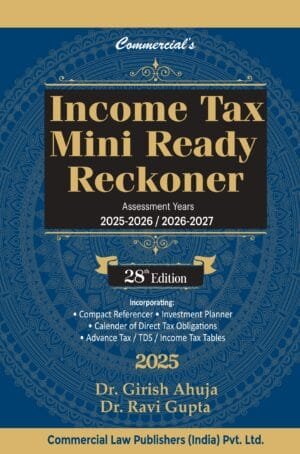Centax Customs Law Manual By R K Jain Edition 2025
Centax Customs Law Manual By R K Jain Edition 2025
Description
R.K. Jain’s Customs Law Manual is a longstanding and authoritative reference work widely regarded as a cornerstone for customs-related statutes, regulations, and procedural guidance in India. This two-volume manual combines the full text of the Customs Act 1962 and allied rules, regulations, forms, notifications, and allied legislation relevant to imports, exports, warehousing, baggage, and many other critical areas of customs operations. Initially launched in 1986, the manual has evolved through decades of policy updates, government notifications, and judicial interpretations.
This book is intended for the following audience:
- Customs Practitioners and Tax Consultants – Lawyers, chartered accountants, and consultants dealing with customs, excise, or indirect taxation will find this manual essential for day-to-day reference and expert analyses
- Corporate Legal & Compliance Teams – Companies involved in import/export operations, supply chain management, freight forwarding, and logistics need reliable information to ensure compliant procedures and documentation
- Government Officials & Academicians – Customs officers, departmental adjudicators, and students or researchers in law or commerce seeking a thorough understanding of the Indian customs framework
- Importers & Exporters – Business owners, Customs House Agents (CHAs), and exporters/importers looking for clear guidelines on procedures and documentation for hassle-free compliance
The Present Publication is the 73rd Edition | 2025-26 and has been updated till 1st February 2025. This book is edited by R.K. Jain and has been divided into nine parts:
- [Comprehensive Statutory Text] Complete coverage of the Customs Act, 1962 and all significant rules, regulations, and amendments, consolidated into a user-friendly format
- [Latest Amendments] Incorporates all relevant updates, notifications, and circulars up to 1st February 2025, ensuring readers have access to the most current legal position
- [Extensive Commentary & Notes] Provides expert commentary, cross-references, and insightful notes clarifying complex legal provisions and procedural steps
- [User-friendly Structure] Divided into multiple parts across two volumes, making navigation intuitive—whether searching for specific rules, forms, or allied legislation
- [Practitioner-oriented Tools] Includes sample forms, bonds, checklists, and references designed to help professionals, traders, and departmental officers practically apply customs law
- [Historical and Evolutionary Perspective] Marginal notes on historical amendments and references to earlier editions inform the user about significant changes over time
- [Quick Reference Abstracts] Volume-based indexing and a handy abstract of contents let readers pinpoint the required chapter or form swiftly
The coverage of the book is as follows:
- Volume 1
- Introduction to Customs Law and Procedures – Explains the basic principles, authorities, and procedures in customs administration
- Customs Act 1962 – Full text with chapter-wise detailed coverage, from the appointment of customs ports and airports to provisions on prohibited goods, valuation, import/export procedures, warehousing, adjudication, appeals, and penal provisions
- Customs Rules & Regulations – A compendium of critical rules (e.g., Customs Valuation Rules, Customs Appeals Rules, etc.) and allied notifications that further clarify or modify provisions of the Act
- Volume 2
- Customs Forms & Bonds – Collection of requisite forms for import, export, warehousing, transhipment, baggage declarations, along with sample bonds and undertakings
- Allied Acts, Rules, and Regulations – Coverage of relevant statutes and guidelines that have a direct bearing on customs practice, such as allied import/export regulations and procedures
- Procedural Chapters & Interpretations – Chapters on cargo consolidation, refunds under Customs/IGST, baggage rules, courier clearances, and more, illustrated with helpful instructions
- Special Economic Zones (SEZ) – Sections detailing provisions, forms, and compliance guidelines specific to SEZs
The structure of the book is as follows:
- Clear Segmentation by Topic
- Each volume is divided into multiple parts (Part I, II, III, etc.), further broken into chapters that reflect a logical progression of customs processes—starting from definitions and basic concepts to specialised areas like warehousing, refunds, audits, and settlement commissions
- Table of Contents & Abstracts
- At the front of each volume, you’ll find an elaborate table of contents and abstracts for quick reference. Chapter and part headings indicate the coverage and relevant statutory references
- Appendices & Forms
- The concluding sections collate commonly used forms, departmental bonds, declarations, and instructions, arranged alphabetically or by subject matter for rapid retrieval
- Annotations & Marginal Notes
- Within statutory texts, references to related rules, judicial precedents, or departmental circulars appear alongside the main section, helping readers gain a contextual understanding
About the author
Sh. R.K. Jain, the renowned author of Indirect Taxes including Customs, Central Excise, Service Tax, Foreign Trade Policy (FTP), GST and FEMA. He made his debut in early seventies and in the year 1975, he brought out Customs & Excise Tariffs and Manuals which have recently celebrated Silver/ Golden Jubilee Editions.
Excise Law Times (E.L.T.) edited by Sh. R.K. Jain was launched nearly 45 years ago and it brought awakening in the field of Central Excise and Customs. It has grown to be the prime journal on the subject with largest circulation.
Another Journal, ‘Service Tax Review’ was started in the year 2006 and finally R.K. Jain’s GST Law Times was introduced in 2017, after the advent of GST, the major Indirect Tax Reform. EXCUS is the digital version of these Journals.
| Weight | 4.3 kg |
|---|---|
| bookauthor | R K Jain |
| binding | Paperback |
| edition | 73rd Edition 2025-2026 |
| hsn | 49011010 |
| isbn | 9789391055653 |
| language | English |
| publisher | Centax Publication |
Related products
Original price was: ₹3,895.₹3,115Current price is: ₹3,115.














Reviews
There are no reviews yet.